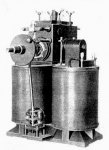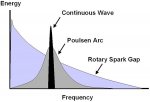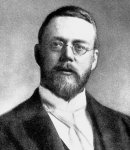- Joined
- Jun 13, 2018
- Messages
- 869
.
It seems there comes and goes a fascination with Morse Code by modern hams. I think it fascinates us to be able to have our own special way of communicating that others don't understand.... I know, even in this day of computers and personal data devices, quite a few of the younger generation that find it a mesmerizing skill .
.
That said, I was going thru files and came across some notes I had from awhile ago. I had been a guest lecturer to Midshipman at the US Naval Academy, talking about one of my favorite subjects; Radio's History.
.
The Academy sits in the shadows of the three remaining 600 foot Eiffel towers- all that is left of the once powerful station NSS. A walk about the former site on Greenbury Point, and looking up at those towers from their bases, can't but impress what the former days of Spark, Alternators and long wave must have been like.
For this talk I brought along a lab constructed rotary spark gap transmitter for a demonstration, along with this on my laptop;
.
Spark Transmitter
.
....one of the best places for the sights, sounds and theory on all things spark gap.
At this site are examples of the Morse audios that I used, as well as one of the most enigmatic recordings - the sounds of voice modulated spark.
.
Its nice that Morse is only a passing memory as far as a ham license is concerned. The more it fades into history, the more interested I am.
.
.
.
Lauri...
.
.
_______________________________________________________________________________________
.
.
Below is the top section of one of those 600 foot towers... note the platform for the huge Shreve wheel over which the massive cables of the antenna array passed. That fence-like structure about the top is a Faraday shield.
.
I have been offered several times, the rare opportunity to climb one of these towers (note the open ladders and lack of any safety cages, platforms etc.) -- getting to experience all the non OSHA era fun of a 1930's steeple jack.
.
My answer to such a tempting invitation "You must think I am out of my ever-loving mind !"
.
.
.
.
It seems there comes and goes a fascination with Morse Code by modern hams. I think it fascinates us to be able to have our own special way of communicating that others don't understand.... I know, even in this day of computers and personal data devices, quite a few of the younger generation that find it a mesmerizing skill .
.
That said, I was going thru files and came across some notes I had from awhile ago. I had been a guest lecturer to Midshipman at the US Naval Academy, talking about one of my favorite subjects; Radio's History.
.
The Academy sits in the shadows of the three remaining 600 foot Eiffel towers- all that is left of the once powerful station NSS. A walk about the former site on Greenbury Point, and looking up at those towers from their bases, can't but impress what the former days of Spark, Alternators and long wave must have been like.
For this talk I brought along a lab constructed rotary spark gap transmitter for a demonstration, along with this on my laptop;
.
Spark Transmitter
.
....one of the best places for the sights, sounds and theory on all things spark gap.
At this site are examples of the Morse audios that I used, as well as one of the most enigmatic recordings - the sounds of voice modulated spark.
.
Its nice that Morse is only a passing memory as far as a ham license is concerned. The more it fades into history, the more interested I am.
.
.
.
Lauri...
.
.
_______________________________________________________________________________________
.
.
Below is the top section of one of those 600 foot towers... note the platform for the huge Shreve wheel over which the massive cables of the antenna array passed. That fence-like structure about the top is a Faraday shield.
.
I have been offered several times, the rare opportunity to climb one of these towers (note the open ladders and lack of any safety cages, platforms etc.) -- getting to experience all the non OSHA era fun of a 1930's steeple jack.
.
My answer to such a tempting invitation "You must think I am out of my ever-loving mind !"
.
.
.
.
Attachments
Last edited by a moderator:






